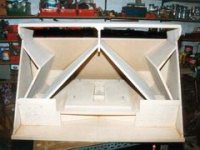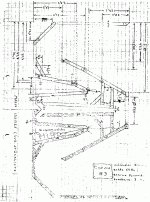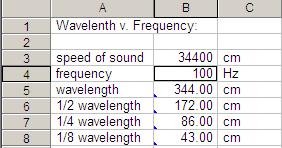Hi hellonwheels,
You are bringing up some interesting points.
To your first paragraph, "...No port compression there...": you are quite directly opposing part of Tom Danley's explanations for the rational for the tapped horn. There was a long discussion of this subject in the collaborative tapped horn thread.
Second paragraph, "...the same thing with the 3015lf in 160l? it actually has a bit more xmax...". I may be wrong, but US Speaker lists the B&C 15TBX100 with 10mm, and the Eminence Eminence Kappa Lite 3015LF with 9.6mm. Maybe I cannot get there from here because of the price difference? When you are trying to get to 125dB @ 40Hz without exceeding 10mm excursion with a 15" driver you have your work cut out for you. By the way the martinsson enclosure (TH-Mini style) has a Hornresp net volume of 167 L.
When you are trying to get to 125dB @ 40Hz without exceeding 10mm excursion with a 15" driver you have your work cut out for you. By the way the martinsson enclosure (TH-Mini style) has a Hornresp net volume of 167 L.
Third paragraph, "... I would like to see the 3015lf in a very well braced, extremely light yet stiff enclosure around the size of the martinsson horn. That would be the pound for pound performance winner, also in a small package, yet hitting 125@40..." - A great goal, I guess you could sell a few of those. Jbell, screamerusa and others, including me, are waiting for this one.
Fourth paragraph, "...the max SPL numbers on the Danley site are calculated, not measured..." As I understand it Tom advocates and uses a 10m/100W measurement in the open field to get around some of the limitations inherent in measuring low frequency loudspeakers, and only then are different levels/distances calculated from that data set. That sounds like a very valid and difficult test to me. Max SPL values is something manufacturers have to list because customers are ......
I can get you a fine Hornresp simulation for the 3015LF with 320 L, but that may just not be small enough.
Regards,
You are bringing up some interesting points.
To your first paragraph, "...No port compression there...": you are quite directly opposing part of Tom Danley's explanations for the rational for the tapped horn. There was a long discussion of this subject in the collaborative tapped horn thread.
Second paragraph, "...the same thing with the 3015lf in 160l? it actually has a bit more xmax...". I may be wrong, but US Speaker lists the B&C 15TBX100 with 10mm, and the Eminence Eminence Kappa Lite 3015LF with 9.6mm. Maybe I cannot get there from here because of the price difference?
Third paragraph, "... I would like to see the 3015lf in a very well braced, extremely light yet stiff enclosure around the size of the martinsson horn. That would be the pound for pound performance winner, also in a small package, yet hitting 125@40..." - A great goal, I guess you could sell a few of those. Jbell, screamerusa and others, including me, are waiting for this one.
Fourth paragraph, "...the max SPL numbers on the Danley site are calculated, not measured..." As I understand it Tom advocates and uses a 10m/100W measurement in the open field to get around some of the limitations inherent in measuring low frequency loudspeakers, and only then are different levels/distances calculated from that data set. That sounds like a very valid and difficult test to me. Max SPL values is something manufacturers have to list because customers are ......
I can get you a fine Hornresp simulation for the 3015LF with 320 L, but that may just not be small enough.
Regards,
My BR is a big270L box, tuned to a relatively high 38Hz. Huge ports but still short. Other alignments do have a problem with port noise and port compression but I'm pretty sure I wont.
USspeaker is wrong.. xmax is 9mm, xvar is 11 (from B&C)
I think that the sensitivity measurements are taken and the Max Spl is caluclated... not taking into account displacement limits.
When I was referring to 320L and 40hz@ 125 it was 2 160l boxes. (I guess I accidently tossed 7L because this sim is a 160.271 L box.
USspeaker is wrong.. xmax is 9mm, xvar is 11 (from B&C)
I think that the sensitivity measurements are taken and the Max Spl is caluclated... not taking into account displacement limits.
When I was referring to 320L and 40hz@ 125 it was 2 160l boxes. (I guess I accidently tossed 7L because this sim is a 160.271 L box.
An externally hosted image should be here but it was not working when we last tested it.
hellonwheels...
(some random thoughts in regards to the last several posts)
I think once you get your dual 18 into the 'real world' you'll find that the power compression and port compression doesn't end up giving you the max spl you think it will.
http://www.jblpro.com/pub/components/2241.pdf
Check out jbl's specs on power compression for one of their very well regarded drivers... (I just picked one at random) In particular notice that they start listing power compression figures at 60watts. This is part of the reason that a 28v@10m reading like Tom does is so valuable. (even if he does calculate from there -- it's still more honest than calculating from a 1w/1m measurement, which is what ALL other mfg's do.)
And this doesn't apply just to jbl or to BR, but to all types of mfg's and enclosure types. Here's one that happens to use a 3015lf in a FLH... (just so you know I'm not bagging on jbl.)
ProSpeakers Forum - Fitzmaurice Titan 48 - Wayne Parham, October 21, 2007 at 14:31:26
At 100watts/10m, this gives 90db@40hz. At 800watts, it's up to an amazing 93db. 3db difference between 100 and 800 watts. And these tests were done with quick sweeps, no long term coil heating, etc... And the designer claims a 1w/1m reading of 97db@40hz. Hmm....
100watts @ 10meters in an open field, the TH shines due to its directivity, a BR in typical terms is about maxed out at that point because power and port compression are about to kick into high gear. A TH doesn't break or even bend hoffmans law, power compression or any thing else you learned in physics class, but directivity changes the ballgame completely... A TH has it, nothing else short of a cardioid bass array does.
(some random thoughts in regards to the last several posts)
I think once you get your dual 18 into the 'real world' you'll find that the power compression and port compression doesn't end up giving you the max spl you think it will.
http://www.jblpro.com/pub/components/2241.pdf
Check out jbl's specs on power compression for one of their very well regarded drivers... (I just picked one at random) In particular notice that they start listing power compression figures at 60watts. This is part of the reason that a 28v@10m reading like Tom does is so valuable. (even if he does calculate from there -- it's still more honest than calculating from a 1w/1m measurement, which is what ALL other mfg's do.)
And this doesn't apply just to jbl or to BR, but to all types of mfg's and enclosure types. Here's one that happens to use a 3015lf in a FLH... (just so you know I'm not bagging on jbl.)
ProSpeakers Forum - Fitzmaurice Titan 48 - Wayne Parham, October 21, 2007 at 14:31:26
At 100watts/10m, this gives 90db@40hz. At 800watts, it's up to an amazing 93db. 3db difference between 100 and 800 watts. And these tests were done with quick sweeps, no long term coil heating, etc... And the designer claims a 1w/1m reading of 97db@40hz. Hmm....
100watts @ 10meters in an open field, the TH shines due to its directivity, a BR in typical terms is about maxed out at that point because power and port compression are about to kick into high gear. A TH doesn't break or even bend hoffmans law, power compression or any thing else you learned in physics class, but directivity changes the ballgame completely... A TH has it, nothing else short of a cardioid bass array does.
While my schedule is still busy, I have decided to renew my interest in subjects acoustic.
I notice you are still actively supporting your horn simulation program.
Hi Bill,
Pleased to hear that life is treating you a bit more fairly these days.
Hornresp has certainly come a long way since you first requested a copy of Version 1.40 more than ten years ago
Kind regards,
David
Limit
Acoustic Bend Limit
Once the transverse passage width [W] of a horn bend becomes greater than ½ the wavelength of the highest frequency to be passed [fh], wave propagation around the bend becomes chaotic and cancellation at certain frequencies above [fh] occurs. This is accompanied by a marked increase in bend reflectance that generates strong back-waves that return to and impinge on the driver diaphragm.
For long horns that require several bends to fold them up into a compact footprint, passage bifurcation may be employed to reduce (halve) bend width and thus avoid the ‘acoustic wide bend problem’.
As early as 1877 (and probably earlier), Lord Rayleigh (Theory of Sound) recognized that these departures form a straight single passage duct have a negligible effect on the propagation of long acoustic waves through them, so long as the ducts involved remained acoustically slender [W]<[c]/(2*[fh]), or in other words, the waves remained acoustically long [fh]< [c]/(2*[W]).
Regards,
WHG
Danley mentioned that its better to make the sharpest bends near the throat. This is the Jbell SS15 way. Presumably its a better sounding fold than Martinsson where the u turns are nearer to the mouth.
Acoustic Bend Limit
Once the transverse passage width [W] of a horn bend becomes greater than ½ the wavelength of the highest frequency to be passed [fh], wave propagation around the bend becomes chaotic and cancellation at certain frequencies above [fh] occurs. This is accompanied by a marked increase in bend reflectance that generates strong back-waves that return to and impinge on the driver diaphragm.
For long horns that require several bends to fold them up into a compact footprint, passage bifurcation may be employed to reduce (halve) bend width and thus avoid the ‘acoustic wide bend problem’.
As early as 1877 (and probably earlier), Lord Rayleigh (Theory of Sound) recognized that these departures form a straight single passage duct have a negligible effect on the propagation of long acoustic waves through them, so long as the ducts involved remained acoustically slender [W]<[c]/(2*[fh]), or in other words, the waves remained acoustically long [fh]< [c]/(2*[W]).
Regards,
WHG
my scientific english is not so goodAcoustic Bend Limit
For long horns that require several bends to fold them up into a compact footprint, passage bifurcation may be employed to reduce (halve) bend width and thus avoid the ‘acoustic wide bend problem’.
WHG

see if i understand this correct.
lets say the fh is 100 hz 34.3/2 is 17 cm.
an enclosure of 53 high,if the inside pannels of the horn are, lets say 50 cm ,you best divide it around the bends in 3?
regards erik
my scientific english is not so good
see if i understand this correct.
lets say the fh is 100 hz 34.3/2 is 17 cm.
an enclosure of 53 high,if the inside pannels of the horn are, lets say 50 cm ,you best divide it around the bends in 3?
regards erik
This is good practice as well, particularly when extended beyond the bend.
Here are some examples of the passage bifurcation to which I refer:
Klipsch:

PA Tub

Regards,
WHG
MicroScoop ?
Hey guys, as some know it, even I have my 6 T48 Bill design, with which I am not happy in the sense that they do not fall over 50Hz and feel that life lacks the bass of the music.
Now I commented that I have 20 speakers 15 ", 6 of which I have in the T48 and 4 speakers I have a pair of HD215.
Some friends told me I could try the good TUBA36 and talked so much of the T48, that today and I have my doubts, for that reason, reading and looking at the forum, I read that Mr. Staiper says 12 MICROSCOOP ERS sound very well, what is not said is how many HZ are able to lose such microscoopers, because if they are within 50HZ, serious bass very similar to the T48 that I have.
Another possibility I see is to make super scooper with 2 speakers 15 "Super Scooper maybe with 1 double, I heard a super scooper 18".
The problem is that I have many speakers 15 "and for the moment I can not buy speakers 18", but if I would like to help me with their opinions, to choose a design for a 30Hz - 35Hz, and submit with my HD215.
Hey guys, as some know it, even I have my 6 T48 Bill design, with which I am not happy in the sense that they do not fall over 50Hz and feel that life lacks the bass of the music.
Now I commented that I have 20 speakers 15 ", 6 of which I have in the T48 and 4 speakers I have a pair of HD215.
Some friends told me I could try the good TUBA36 and talked so much of the T48, that today and I have my doubts, for that reason, reading and looking at the forum, I read that Mr. Staiper says 12 MICROSCOOP ERS sound very well, what is not said is how many HZ are able to lose such microscoopers, because if they are within 50HZ, serious bass very similar to the T48 that I have.
Another possibility I see is to make super scooper with 2 speakers 15 "Super Scooper maybe with 1 double, I heard a super scooper 18".
The problem is that I have many speakers 15 "and for the moment I can not buy speakers 18", but if I would like to help me with their opinions, to choose a design for a 30Hz - 35Hz, and submit with my HD215.
- Status
- This old topic is closed. If you want to reopen this topic, contact a moderator using the "Report Post" button.
- Home
- Live Sound
- PA Systems
- Dual 18" PA subs for live sound in club...
